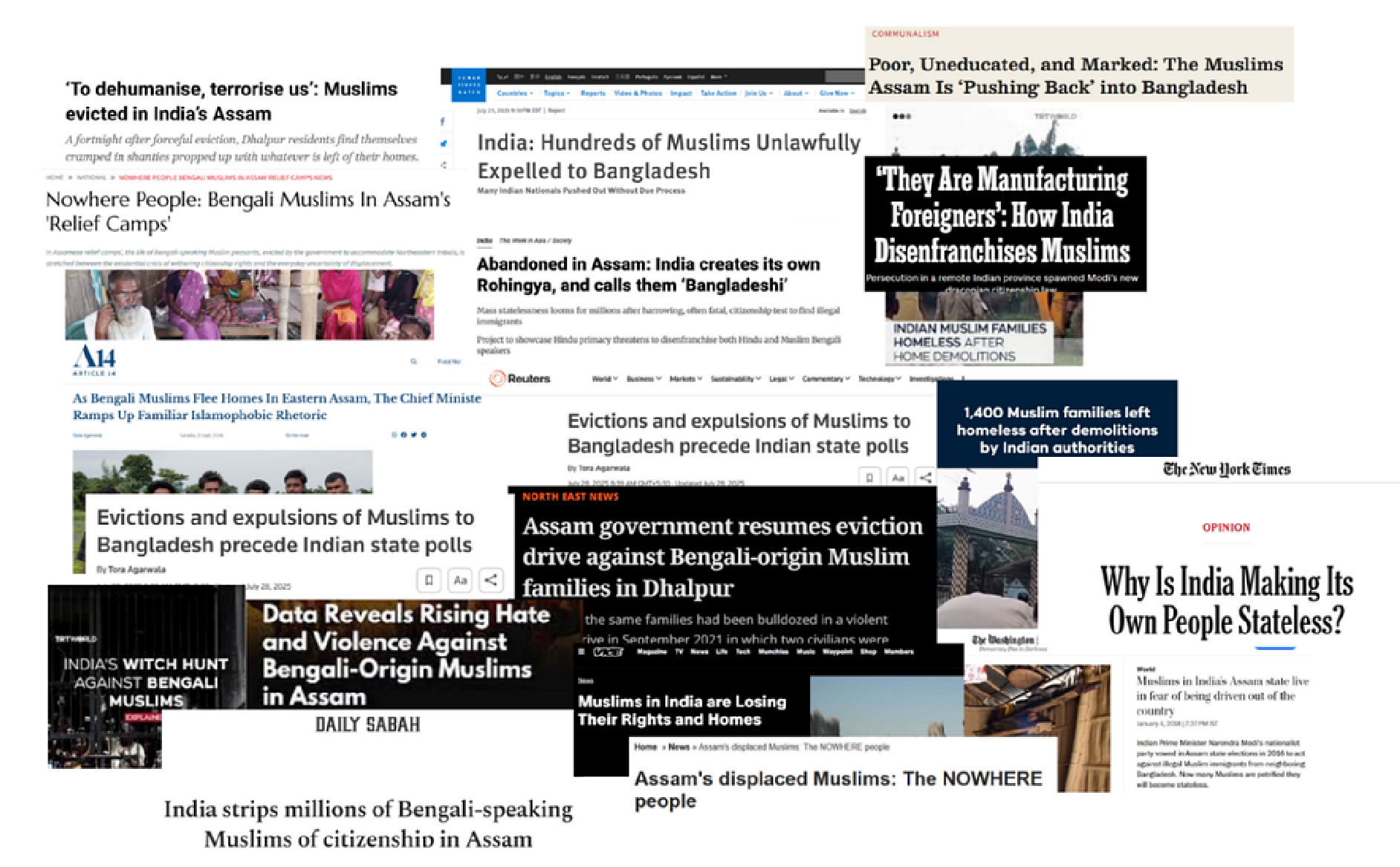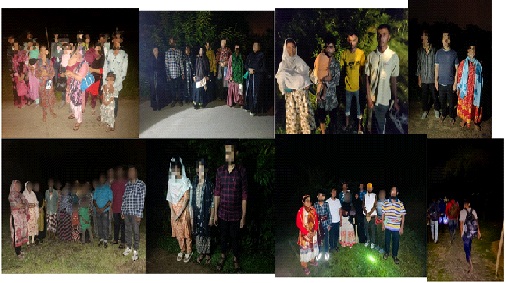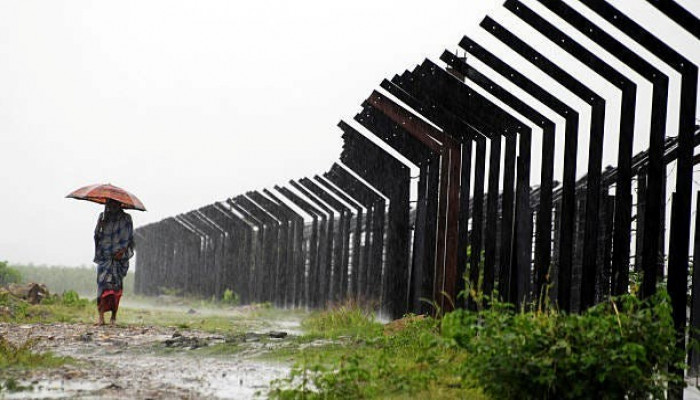Assam: How Language Shapes the Narrative on Illegal Migration
- In Current Affairs
- 10:34 AM, Sep 30, 2025
- MeowMarx
Note: Foreign media refers to international outlets, also addresses the left and communist intelligentsia.
Extending the much-debated case of Narrative Warfare, the stateʼs sheer incompetence to theorise this ‘threatʼ of War of Narratives and Information as a real threat in the consciousness of the Babu-cracy (bureaucracy), further sidelines “netizens” appeal to take notice of this matter.
How the foreign media apparatus, while covering Assam’s illegal immigrant issue, utilises semantic distortion, also known as soft language, to soften reality, provide digital cover, and obscure the intensity of the facts. It portrays infiltrators as victims and defenders as offenders; trespassers are pardoned while natives are maligned; and illegal immigration is not seen as a ‘crime,’ but deportation is treated as the greatest crime.
When these micro-steps are reiterated over time by the foreign press, they subtly tweak the narrative, help shape beliefs, and alter people’s attitudes toward a specific topic or situation. A slight nudge toward 'concealing the reality' and 'taking the life out of life,' as George Carlin used to call it.
How Narrative Wars Are Playing Out in Assam?
Narrative Warfare: The strategic, systematic, and purposeful manipulation of narratives and information to shape public perception, create meaning, and influence audiences to support a particular agenda or goal.

Screenshots of articles from the foreign press.
These articles have been published in the last ten years or so by the foreign press on the issue of illegal migrants from Bangladesh infiltrating the northeastern states of India, namely Assam, Tripura, Meghalaya, etc.
A common theme runs across these headlines: Bengali Muslims, Bengal-origin Muslims, Bengali-speaking Muslims and simply Muslims.
For an Indian reader, especially one from Assam or the Northeast, these headlines may seem threatening and problematic. Moreover, as truth-bending propaganda, they are far removed from reality because they assign common nomenclatures such as pedestrian words to ‘illegal immigrantsʼ' instead of calling them ‘Bangladeshisʼ. However, for a foreign eye, an eye foreign to the situation and the land, may not find these headlines problematic and may perceive them as they are, distant from reality, while subtly shifting their mindset, and of course, creating a negative public perception.
These words work like a fabric softener, softening the seriousness of reality, desensitising people to the presence of illegal aliens, legitimising their status, and making them appear as natives of the land, forcefully assimilated into the Assamese Muslim populace.
To put it simply, strawmanning the half-century-old issue of cross-border infiltration from Bangladesh in foreign perception, which also produces second-order effects.
Cross-Border Infiltration from Bangladesh: A Short Overview
Bangladesh shares 4,096 km or 2,545 miles of land border with India, surrounding it on all three sides.

Illegal Bangladeshi immigrants arrested by Assam Police.
Ever since the partition of India in 1947, when Bangladesh was still East Pakistan, illegal immigration from Bangladesh has been a perennial pressure on Indiaʼs resources, national security, and bordering states. It has substantially contributed to changing the demographic pattern in the northeastern states of India, where the locals feel overwhelmed by outsiders. The nature of the influx has been of two types: labour migrants and refugees (the latter being the persecuted minorities of Bangladesh, though both contribute to the overall influx). There are an estimated 20 million illegal migrants, based on census data, population growth, and demographic statistics from Bangladesh (BBS) and India (Ministry of Home Affairs).
Among them, labour migrants make up the majority, working in the blue-collar sector (menial jobs), such as house workers, rickshaw pullers, and garbage collectors. They end up snatching jobs of Indiaʼs own labour class, which typically earns higher wages. These infiltrators enter India through porous parts of the border: thick dense jungle, water streams, or over fences. It has become so serious that it has acquired an art form, a specific niche in Bangladeshʼs Facebook content space, where youʼll find tutorials teaching how to cross the border. It has also contributed to fuelling insurgency in some of the bordering states.
We see a persistent behaviour of deniability for decades from Dhaka that its citizens have been emigrating illegally to India, nor has it taken any effective measures to control the flow of its nationals into India. Efforts over the decades to stem the tide by erecting a barbed-wire fence along the border and stepped-up surveillance have failed to produce the desired results for India, due to the borderʼs configuration and non-cooperation from the other side. Furthermore, Dhakaʼs refusal to take back its own citizens and its laid-back bureaucratic repatriation framework reveal the deep-settled failure of Bangladesh, and this failure heightens the fear and rings alarm bells in New Delhi that this is a deliberate design by Dhaka to settle its citizens on Indian soil to claim territory in Indiaʼs east and north-east. For more, here
How Soft Language hijacks perception: Victimization of Bangladesh?
Soft language: Using milder or less direct language to avoid conflict, harshness, or accountability.
Bengali Muslims, Bengali-origin Muslims, Bengali-speaking Muslims, and simply Muslims. Words like these completely shield Bangladesh from world scrutiny, misrepresenting the situation and removing it from the perception of accountability of readers sitting far away, while singling out one narrative and fixating the Worldʼs attention only on the manufactured miscreant of India. These words are a red herring for Bangladesh, as they hide Dhakaʼs inability to create conditions in which people will have no compulsions to emigrate to India and will close the valve that fuels insurgency inside Indian territory, which is consciously ignored by the foreign press under the garb of soft words. Moreover, these words also hide their fractured system of governance that has generated over 29 military coups (not all successful), which erodes faith in its political order and pushes people away from the country.
These journalists and columnists specifically pick these words to rob intellect from peopleʼs perception. The venom of this narrative-building is that they completely paint India in an Islamophobic colour while closing their eyes to the persecution of their minorities, precisely Hindus in Bangladesh. At the time of independence in 1971, Hindus formed a notable segment of the population, around 31% in 1947. However, by 2022, their share had declined to approximately 7.95%. Between 1964 and 2013, approximately 11.3 million Hindus migrated out of the country. For more, click here.
How the identity of Bangladeshi Muslims is diluted into mere ‘Muslimsʼ' through soft language:
Bengali Muslims → Bengali Muslim Communities → Bengali Muslim Families → Bengali Muslim Households → Bengali Muslim Diasporas → Bengali-origin Muslims → Muslim Communities of Bengali Heritage → Followers of Islam from Bengal → Bengali Faithful Communities → Peoples of Bengali Heritage → Bengali-background Residents → Families of Bengali Descent → Residents with Bengali Roots → Peoples of the Bengal Region → Bengal-based Minority Communities → Communities with Ties to Bengal → Bengal-rooted Families → Bengal-based Communities → Bengali Cultural Groups → Peoples of
Bengali Origin → Migrant-origin Communities → Muslim Migrants → Migrant Labours → Muslim Labours → Local Muslims → Local Residents → Muslims…
What are the second-order effects of these narratives?
These narratives have a ripple effect on the mindset of policymakers and the political class in foreign countries. At times, it makes them dismissive and ignorant of the gravity of another nationʼs reality. One can observe this effect reflected in their discourse: from pressers to policies, from the UN floor to live political speeches. It reverberates across mainstream newsrooms, penetrates domestic spaces, and eventually influences academic debates and student worldview overseas.
A country may win a war on the ground but can lose it in the perception of the world. These journalists behave as if they are the sole authority or the true source of communications. Narrative Warfare is a multidimensional phenomenon; it employs an entire web of information-sharing and transmission apparatus — communication technologies, media organisations, academia, and social media coverage — all of which contribute to the formation of identity and perception.
Capital dispensation is a vital component of Narrative Warfare, as it sustains these individuals who deliver their rhetoric, destroying reality sentence by sentence. They include scholars, journalists, activists, poets, theorists, historians, content writers, public intellectuals, politicians, bureaucrats, Twitter commentators, and many of whom, in most cases, are employed by NGOs, foreign political entities, lobbyists, corporations, intelligence agencies, and others with vested interests, operating through back channels.
Conclusion
In the truest sense, this is Orwellian fiction materialised. A country like India finds itself at the receiving end of these narratives because once you start countering a narrative, the goalpost shifts. Whoever has a firm grip on the source controls the narrative and changes perception, which constructs the notion.
© Wokeistan.







Comments